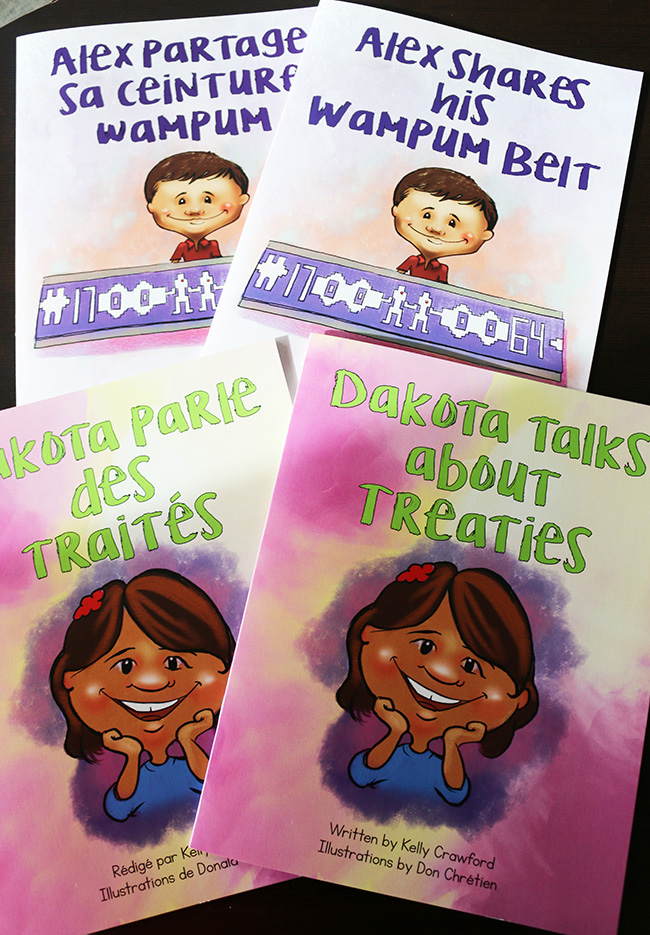Book Review: Two new books for elementary students on Treaties

Reviewed by Carrie MacKenzie
“Alex Shares His Wampum Belt” and “Dakota Talks About Treaties” are both written by Kelly Crawford and illustrated by Don Chrétien. Both of these books deal with the same topic but teach different aspects of it.
The Alex book explains what Wampum belts are and their significance with respect to treaties. Dakota’s book goes further, explaining what treaties are and their importance.
These stories are meant to be read aloud by teachers to their classes at the elementary school level.
The language used by Crawford, who is a citizen of M’Chigeeng First Nation, is easily understood by children. This helps them to understand the lesson being taught and its importance and relevance to their lives. This is just one facet that makes these books an excellent tool for any elementary classroom.
Adding to the impact and usefulness of these stories as teaching tools are the narrators. Both Alex and Dakota are children like the target audience. This increases the reader’s interest in and feelings of connection to the story and what is being said. It helps them understand and internalize the information being presented therefore, the message of these stories will have more of an impact.
The length of these stories allows them to be useful in the classroom. They are long enough to teach important lessons on First Nations and short enough that the students remain engaged as they listen to their teacher read them. This increases the chance that these stories will resonate with them.
Further adding to the usefulness of these books as a teaching tool is the fact that both have “Teacher Quick Tips” and a “Teacher Reference” located at the back of each book with helpful information and suggestions. These help the teacher present this topic in an informed and respectful way. Also, these books can be used as a set as one naturally flows into the other. “Dakota Talks About Treaties” references “Alex Shares His Wampum Belt” and continues to expand on the topic of treaties.
These stories also show respect for Indigenous culture by having the preamble to the Chi-Naaknigewin (Anishinabek Nation Constitution) at the beginning of the book in Anishinaabemowin. The narrators, Alex and Dakota, also introduce themselves in Anishinaabemowin. These are then translated into English. This exposes the reader to the language and the traditional way of introducing yourself, something they may have never been exposed to before.
The tone of these books is one of reconciliation and mutual respect. They have upbeat feel to them, there is no negativity.
The reader is made to realize in a gentle way that despite the years that have passed since the treaties were ratified they are still valid and should be honoured by both sides. Again, this makes these stories suitable for younger children learning about First Nation issues.
Don Chrétien’s illustrations are beautiful. They are full of bright colours that catch the reader’s eye and mirror the positive tone of the stories and add to it.
These illustrations also show an example of what a Wampum belt looks like, making the mental image of them created by Crawford words more concrete and real. This adds to the impact of these books and their usefulness as a teaching tool.
Chrétien is a citizen of Nipissing First Nation.
Both of these books would be an excellent addition to any teacher’s resources and be extremely useful tool to teach elementary students about Wampum belts and treaties.
This can bring everyone closer to reconciliation and help heal the wounds of the past.
“Alex Shares His Wampum Belt” By Kelly Crawford, Beatty Printing, $10 ISBN 978-09868211-6-5
“Dakota Talks About Treaties” By Kelly Crawford, Beatty Printing, $10 ISBN 978-0-9868211-7-2
“Alex partage sa ceinture wampum” By Kelly Crawford, Beatty Printing, $10 ISBN 978-0-9868211-9-6
“Dakota parle des traites” By Kelly Crawford, Beatty Printing, $10 ISBN 978-0-9868211-8-9
To order, email orders@anishinabek.ca or call 705-497-9127.


